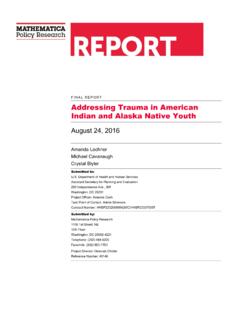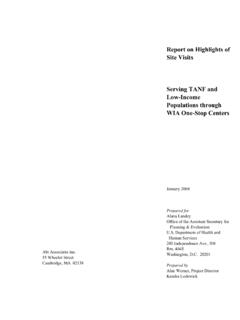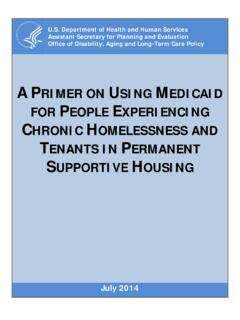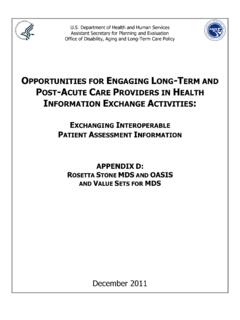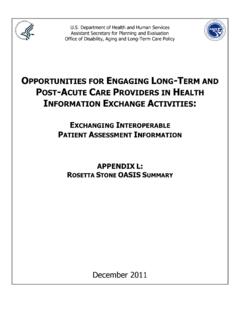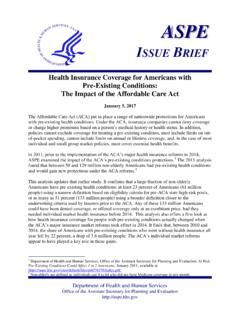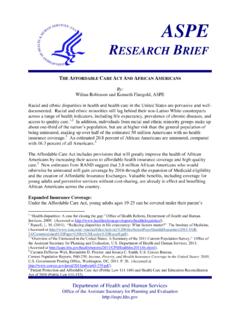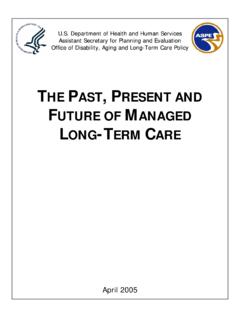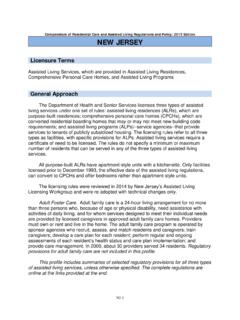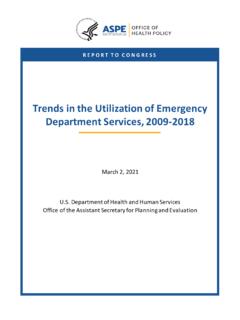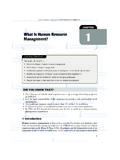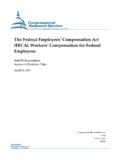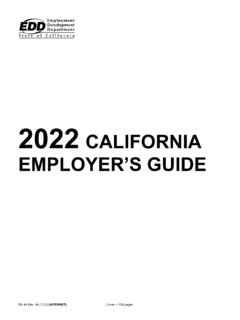Transcription of GUIDELINES FOR REGULATORY IMPACT ANALYSIS
1 GUIDELINES FOR REGULATORY IMPACT ANALYSIS 2016 Office of the Assistant Secretary for Planning and Evaluation Department of Health and Human Services i ACKNOWLEDGEMENTS These GUIDELINES for REGULATORY IMPACT ANALYSIS were prepared for the Department of Health and Human Services (HHS) Analytics Team, under the leadership of Amber Jessup (Office of the Assistant Secretary for Planning and Evaluation). The primary authors were Lisa A. Robinson and James K. Hammitt (Harvard University Center for Risk ANALYSIS and Center for Health Decision Science) and Jennifer R. Baxter (Industrial Economics, Incorporated, IEc). The work was performed between 2013 and 2016 under subcontract to IEc and Mathematica Policy Research; Ms.
2 Baxter was the IEc Project Leader. Dr. Hammitt s work was also supported by an HHS Intergovernmental Personnel Act agreement. The authors were assisted by IEc staff including Lindsay Ludwig, who helped develop the initial drafts of several sections; Margaret Black, who provided additional editorial support and helped draft the related primer; and Michael Welsh, who helped develop the index and glossary. The draft GUIDELINES were independently peer reviewed by Joseph Aldy (Harvard Kennedy School) and David Weimer (La Follette School of Public Affairs, University of Wisconsin-Madison). HHS staff also provided substantial advice and comments, including Evell Barco, Laina Bush, Caroline Cochran, Daniel Converse, Walt Francis, Sherry Glied, Scott Grosse, Kevin Haninger, Amber Jessup, Daniel Lawver, Nellie Lew, Clark Nardinelli, John Rigg, Kakoli Roy, C'Reda Weeden, Daniel Wilmoth, Nancy Zhang, and David Zorn, as well as other Analytics Team members and Centers for Disease Control and Prevention staff.
3 This guidance represents the current thinking of the Department of Health and Human Services (HHS) on the conduct of REGULATORY IMPACT ANALYSIS . It does not establish any requirements for any person and is not binding on HHS, any HHS agencies or the public. You can use an alternative approach if it satisfies the requirements of the applicable Executive Orders and regulations. To discuss an alternative approach, contact the Office of the Assistant Secretary for Planning and Evaluation. ii TABLE OF CONTENTS Acknowledgements .. i Table of Contents .. ii Acronyms .. iii Chapter 1: introduction ..1 What Is REGULATORY IMPACT ANALYSIS ?.
4 1 What Are the Benefits and Costs of Conducting an RIA? ..2 When Is an RIA Required? ..2 What Are the Basic Components? ..3 Chapter 2: Frame the ANALYSIS ..5 Explain the Need for Action and Identify Alternatives ..5 Define the Without Regulation Baseline ..6 Describe the Consequences of Each Policy Alternative ..7 Use Screening to Focus the ANALYSIS ..8 Chapter 3: Assess Benefits .. 10 Basic Concepts .. 10 Valuing Mortality Risk Reductions .. 13 Valuing Morbidity Risk Reductions .. 18 Chapter 4: Assess Costs .. 23 Basic Concepts and Approach .. 23 Assessing Compliance and Government Implementation Costs .. 25 Estimating Market-Level Impacts.
5 35 Chapter 5: Account for Timing .. 36 Basic Concepts and Approach .. 36 Adjusting for Inflation .. 37 Determining Present Values .. 38 Annualizing Impacts .. 41 Chapter 6: Address Uncertainty and Nonquantifiable Effects .. 43 Characterizing Uncertainty in Quantified Effects .. 43 Characterizing Nonquantified Effects .. 47 Chapter 7: Conduct Distributional and Other Supplementary Analyses .. 52 Assess Distribution across Demographic Groups .. 52 Conduct Supplementary Analyses .. 55 Address International Effects .. 58 Chapter 8: Communicate the Approach and Results .. 60 Describe the ANALYSIS and Results .. 60 Provide Summary Tables and Figures.
6 61 Chapter 9: Conduct Retrospective ANALYSIS .. 64 Basic Concepts .. 64 General Approach .. 65 Appendix A: Agency Checklist: REGULATORY IMPACT ANALYSIS (OMB 2010) .. A-1 Appendix B: Consumer and Producer B-1 Appendix C: Methods for Estimating QALYs .. C-1 References .. References-1 Index .. Index-1 Glossary ..Glossary-1 iii Acronyms ASPE Assistant Secretary for Planning and Evaluation BLS Bureau of Labor Statistics CBO Congressional Budget Office CDC Centers for Disease Control and Prevention CEA cost-effectiveness ANALYSIS Census Census Bureau CPI Consumer Price Index CPS Current Population Survey CRA Congressional Review Act DOT Department of Transportation ECEC Employer Costs for Employee Compensation ECI Employer Cost Index EQ-5D EuroQol-5 Dimensions FDA Food and Drug Administration FICA Federal Insurance Contributions Act FRFA Final REGULATORY Flexibility ANALYSIS G&A general and administrative GAO Government Accountability
7 Office GDP gross domestic product GSA General Services Administration HHS Department of Health and Human Services HRQL health-related quality of life HUI Health Utilities Index ICR Information Collection Request IRFA Initial REGULATORY Flexibility ANALYSIS IRS Internal Revenue Service NCS National Compensation Survey NHTSA National Traffic Highway Safety Administration O&M operations and maintenance OES Occupational Employment Statistics OMB Office of Management and Budget PRA Paperwork Reduction Act QALY quality-adjusted life year QCEW Quarterly Census of Employment and Wages QWB Quality of Well-Being RFA REGULATORY Flexibility Act RIA REGULATORY IMPACT ANALYSIS SBA Small Business Administration SBREFA Small Business REGULATORY Enforcement Fairness Act SOP standard operating procedure UMRA Unfunded Mandates Reform Act iv VSL value per statistical life VSLY value per statistical life year WTA willingness to accept compensation WTP willingness to pay 1 WHY PREPARE AN RIA?
8 RIAs provide objective information and ANALYSIS that is essential for evidence-based decision-making. They include a benefit-cost ANALYSIS as well as other analyses mandated by various statutes and executive orders. Chapter 1 introduction Executive Orders 12866 and 13563 (Clinton 1993, Obama 2011) call for a REGULATORY system that protects public health, welfare, safety, and our environment while promoting economic growth, innovation, competitiveness, and job creation. To achieve these goals, the Department of Health and Human Services (HHS) analyzes the benefits, costs, and other impacts of significant proposed and final rulemakings, consistent with the requirements of the executive orders.
9 In the HHS 2011 Plan for Retrospective Review of Existing Rules, the Assistant Secretary for Planning and Evaluation (ASPE) was asked to establish an agency-wide Analytics Team to provide recommendations for strengthening REGULATORY ANALYSIS , leveraging the existing expertise of economists and analysts from throughout the Department s operating The Analytics Team investigated current challenges and determined that guidance was needed to address common difficulties and to ensure consistent treatment across agencies. To meet that need, the Department developed these GUIDELINES for REGULATORY IMPACT ANALYSIS to assist its agencies in conducting economic analyses that meet the goals of the executive orders.
10 This chapter briefly introduces related requirements and the contents of these GUIDELINES . WHAT IS REGULATORY IMPACT ANALYSIS ? A REGULATORY IMPACT ANALYSIS (RIA) reflects a well-established and widely-used approach for collecting, organizing, and analyzing data on the impacts of policy options, to promote evidence-based decision-making. It provides an objective, unbiased assessment that is an essential component of policy development, considering both quantifiable and unquantifiable impacts. Along with information on legal requirements, general policy goals, the distribution of the impacts, and other concerns, it forms the basis of the ultimate policy decision.
